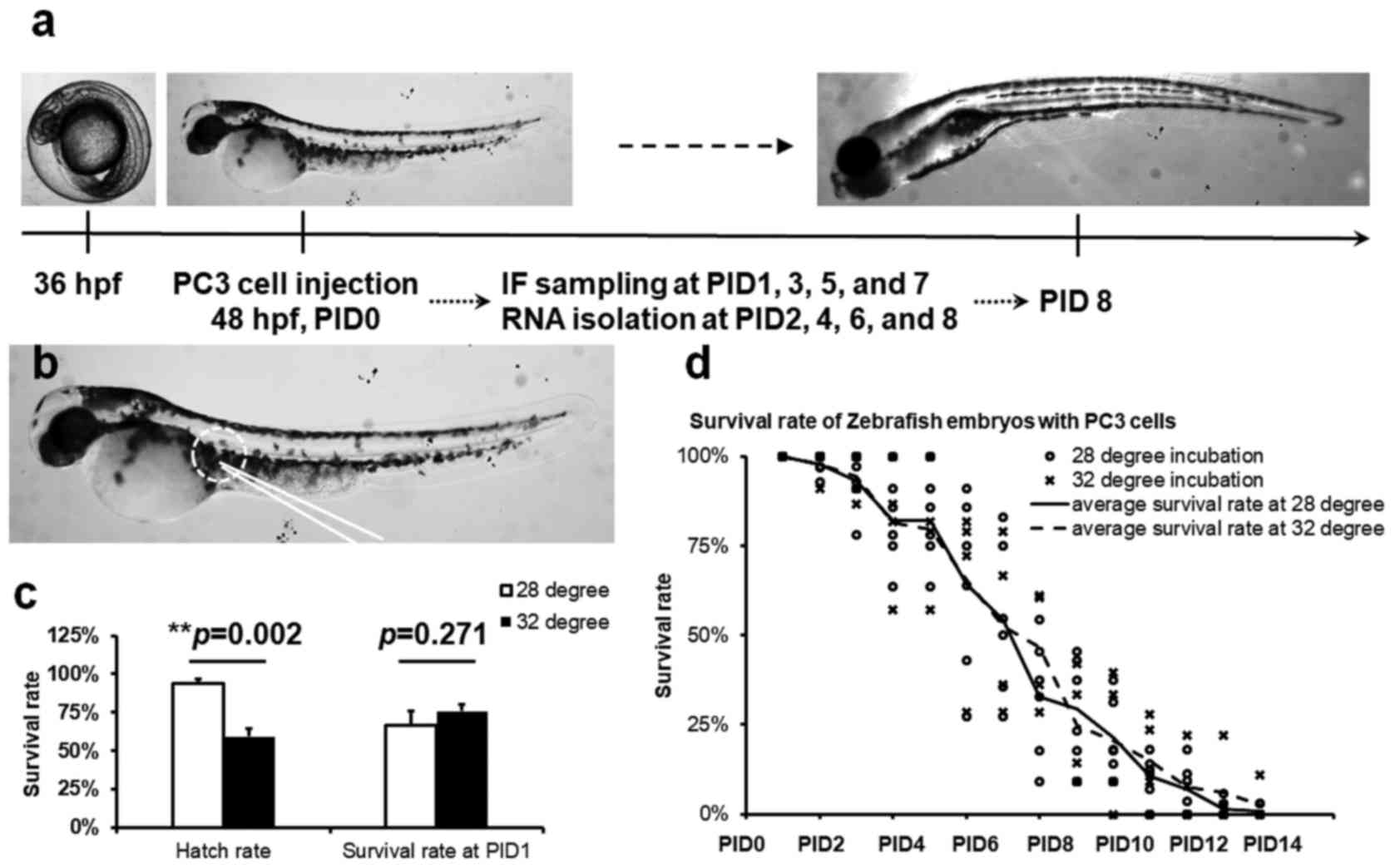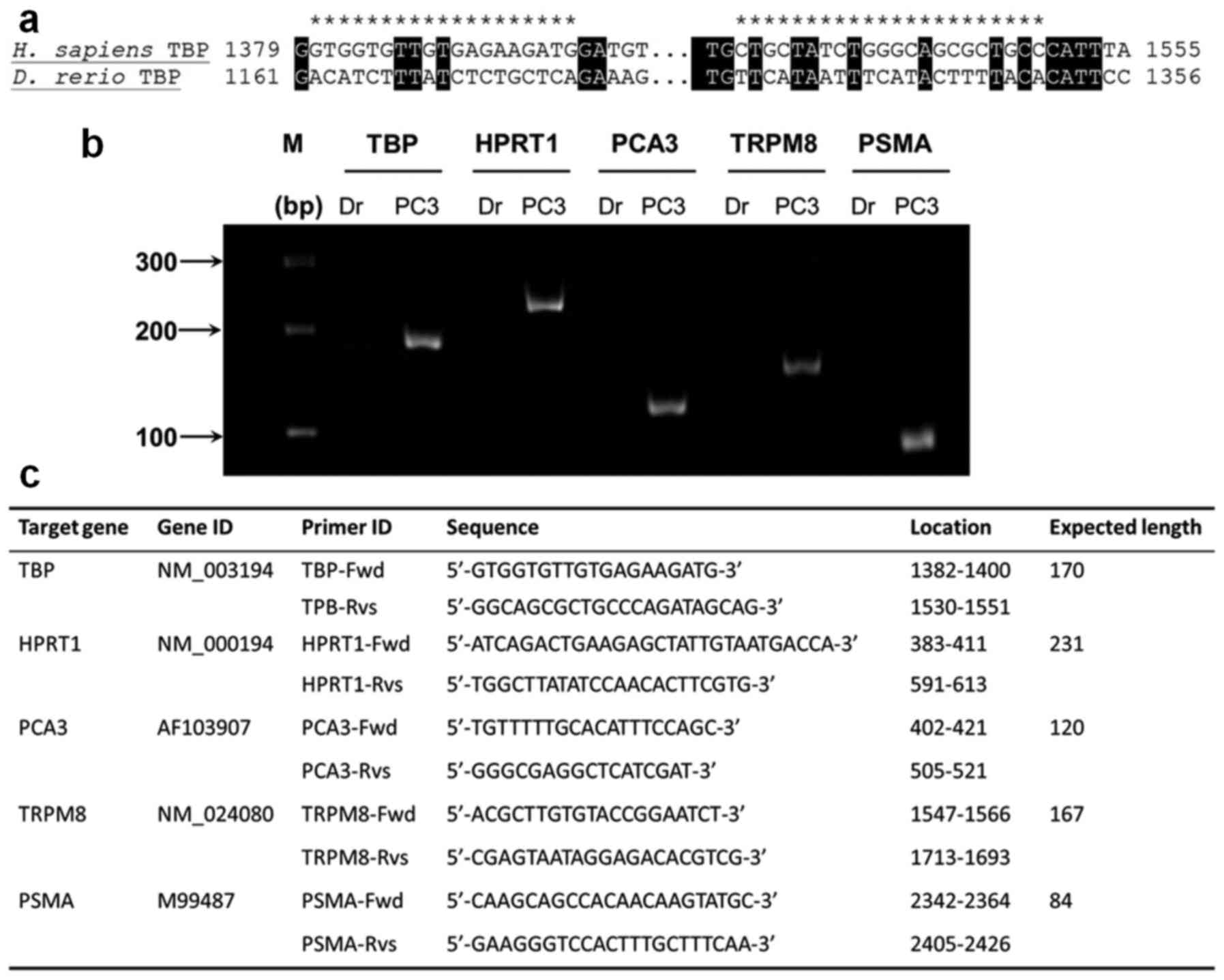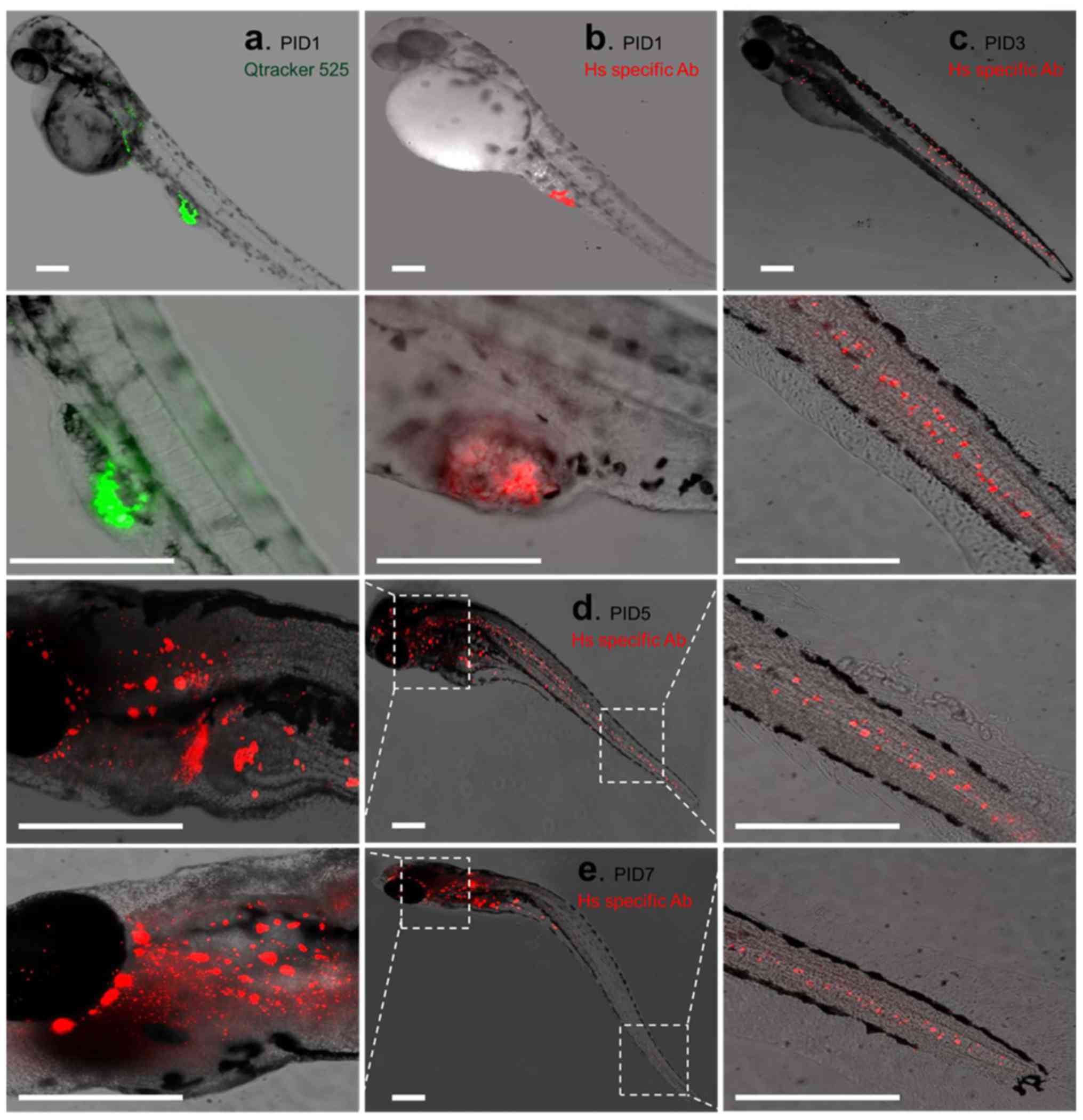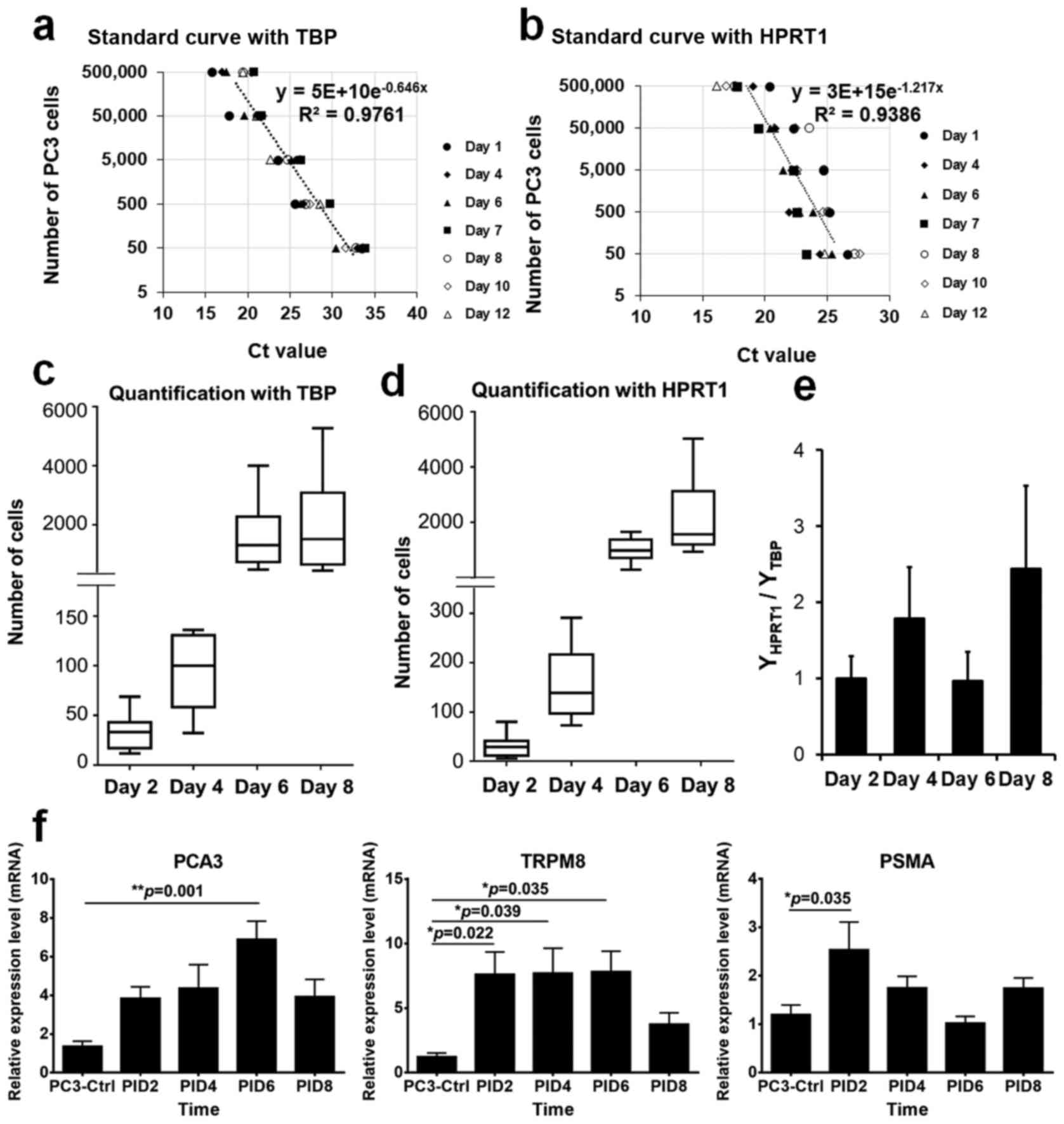|
1
|
American Cancer Society: What are the key
statistics about prostate cancer? 2015
|
|
2
|
van Leeuwen PJ, Connolly D, Gavin A,
Roobol MJ, Black A, Bangma CH and Schröder FH: Prostate cancer
mortality in screen and clinically detected prostate cancer:
Estimating the screening benefit. Eur J Cancer. 46:377–383. 2010.
View Article : Google Scholar
|
|
3
|
Rajasekhar VK, Studer L, Gerald W, Socci
ND and Scher HI: Tumour-initiating stem-like cells in human
prostate cancer exhibit increased NF-κB signalling. Nat Commun.
2:1622011. View Article : Google Scholar
|
|
4
|
Collins AT, Berry PA, Hyde C, Stower MJ
and Maitland NJ: Prospective identification of tumorigenic prostate
cancer stem cells. Cancer Res. 65:10946–10951. 2005. View Article : Google Scholar : PubMed/NCBI
|
|
5
|
Chen Y, Zhao J, Luo Y, Wang Y, Wei N and
Jiang Y: Isolation and identification of cancer stem-like cells
from side population of human prostate cancer cells. J Huazhong
Univ Sci Technolog Med Sci. 32:697–703. 2012. View Article : Google Scholar : PubMed/NCBI
|
|
6
|
Bokhorst LP, Bangma CH, van Leenders GJ,
Lous JJ, Moss SM, Schröder FH and Roobol MJ: Prostate-specific
antigen-based prostate cancer screening: reduction of prostate
cancer mortality after correction for nonattendance and
contamination in the Rotterdam section of the European Randomized
Study of Screening for Prostate Cancer. Eur Urol. 65:329–336. 2013.
View Article : Google Scholar : PubMed/NCBI
|
|
7
|
Shah G: A human cancer cell specific gene
product. USPTO; Shah Girish V: 2011
|
|
8
|
Park SI, Kim SJ, McCauley LK and Gallick
GE: Pre-clinical mouse models of human prostate cancer and their
utility in drug discovery. Curr Protoc Pharmacol Chapter 14. Unit
14.15. 2010. View Article : Google Scholar
|
|
9
|
Hafeez BB, Zhong W, Fischer JW, Mustafa A,
Shi X, Meske L, Hong H, Cai W, Havighurst T, Kim K, et al:
Plumbagin, a medicinal plant (Plumbago zeylanica)-derived
1,4-naphthoqui-none, inhibits growth and metastasis of human
prostate cancer PC-3M-luciferase cells in an orthotopic xenograft
mouse model. Mol Oncol. 7:428–439. 2013. View Article : Google Scholar : PubMed/NCBI
|
|
10
|
Hansen AG, Arnold SA, Jiang M, Palmer TD,
Ketova T, Merkel A, Pickup M, Samaras S, Shyr Y, Moses HL, et al:
ALCAM/CD166 is a TGF-β-responsive marker and functional regulator
of prostate cancer metastasis to bone. Cancer Res. 74:1404–1415.
2014. View Article : Google Scholar : PubMed/NCBI
|
|
11
|
Moshal KS, Ferri-Lagneau KF and Leung T:
Zebrafish model: Worth considering in defining tumor angiogenesis.
Trends Cardiovasc Med. 20:114–119. 2010. View Article : Google Scholar
|
|
12
|
Liu S and Leach SD: Zebrafish models for
cancer. Annu Rev Pathol. 6:71–93. 2011. View Article : Google Scholar : PubMed/NCBI
|
|
13
|
Tat J, Liu M and Wen XY: Zebrafish cancer
and metastasis models for in vivo drug discovery. Drug Discov Today
Technol. 10:e83–e89. 2013. View Article : Google Scholar : PubMed/NCBI
|
|
14
|
Yen J, White RM and Stemple DL: Zebrafish
models of cancer: Progress and future challenges. Curr Opin Genet
Dev. 24:38–45. 2014. View Article : Google Scholar : PubMed/NCBI
|
|
15
|
Patton EE and Zon LI: Taking human cancer
genes to the fish: A transgenic model of melanoma in zebrafish.
Zebrafish. 1:363–368. 2005. View Article : Google Scholar
|
|
16
|
White RM, Sessa A, Burke C, Bowman T,
LeBlanc J, Ceol C, Bourque C, Dovey M, Goessling W, Burns CE, et
al: Transparent adult zebrafish as a tool for in vivo
transplantation analysis. Cell Stem Cell. 2:183–189. 2008.
View Article : Google Scholar : PubMed/NCBI
|
|
17
|
Bansal N, Davis S, Tereshchenko I,
Budak-Alpdogan T, Zhong H, Stein MN, Kim IY, Dipaola RS, Bertino JR
and Sabaawy HE: Enrichment of human prostate cancer cells with
tumor initiating properties in mouse and zebrafish xenografts by
differential adhesion. Prostate. 74:187–200. 2014. View Article : Google Scholar :
|
|
18
|
Shah GV, Muralidharan A, Gokulgandhi M,
Soan K and Thomas S: Cadherin switching and activation of
beta-catenin signaling underlie proinvasive actions of
calcitonin-calcitonin receptor axis in prostate cancer. J Biol
Chem. 284:1018–1030. 2009. View Article : Google Scholar :
|
|
19
|
Westerfield M: The zebrafish book A guide
for the laboratory use of zebrafish (Danio rerio). 5th edition.
University of Oregon Press; Eugene, OR: 2007
|
|
20
|
Schmidt U, Fuessel S, Koch R, Baretton GB,
Lohse A, Tomasetti S, Unversucht S, Froehner M, Wirth MP and Meye
A: Quantitative multi-gene expression profiling of primary prostate
cancer. Prostate. 66:1521–1534. 2006. View Article : Google Scholar : PubMed/NCBI
|
|
21
|
Valente V, Teixeira SA, Neder L, Okamoto
OK, Oba-Shinjo SM, Marie SK, Scrideli CA, Paçó-Larson ML and
Carlotti CG Jr: Selection of suitable housekeeping genes for
expression analysis in glioblastoma using quantitative RT-PCR. BMC
Mol Biol. 10:172009. View Article : Google Scholar : PubMed/NCBI
|
|
22
|
Ohl F, Jung M, Xu C, Stephan C, Rabien A,
Burkhardt M, Nitsche A, Kristiansen G, Loening SA, Radonić A, et
al: Gene expression studies in prostate cancer tissue: Which
reference gene should be selected for normalization? J Mol Med
(Berl). 83:1014–1024. 2005. View Article : Google Scholar
|
|
23
|
Altschul SF, Gish W, Miller W, Myers EW
and Lipman DJ: Basic local alignment search tool. J Mol Biol.
215:403–410. 1990. View Article : Google Scholar : PubMed/NCBI
|
|
24
|
Ferreira LB, Palumbo A, de Mello KD,
Sternberg C, Caetano MS, de Oliveira FL, Neves AF, Nasciutti LE,
Goulart LR and Gimba ER: PCA3 noncoding RNA is involved in the
control of prostate-cancer cell survival and modulates androgen
receptor signaling. BMC Cancer. 12:5072012. View Article : Google Scholar : PubMed/NCBI
|
|
25
|
Bai VU, Murthy S, Chinnakannu K,
Muhletaler F, Tejwani S, Barrack ER, Kim SH, Menon M and Veer Reddy
GP: Androgen regulated TRPM8 expression: A potential mRNA marker
for metastatic prostate cancer detection in body fluids. Int J
Oncol. 36:443–450. 2010.PubMed/NCBI
|
|
26
|
Ghosh A, Wang X, Klein E and Heston WD:
Novel role of prostate-specific membrane antigen in suppressing
prostate cancer invasiveness. Cancer Res. 65:727–731.
2005.PubMed/NCBI
|
|
27
|
Teng Y, Xie X, Walker S, White DT, Mumm JS
and Cowell JK: Evaluating human cancer cell metastasis in
zebrafish. BMC Cancer. 13:4532013. View Article : Google Scholar : PubMed/NCBI
|
|
28
|
Taylor AM and Zon LI: Zebrafish tumor
assays: The state of transplantation. Zebrafish. 6:339–346. 2009.
View Article : Google Scholar
|
|
29
|
Spaink HP, Cui C, Wiweger MI, Jansen HJ,
Veneman WJ, Marín-Juez R, de Sonneville J, Ordas A, Torraca V, van
der Ent W, et al: Robotic injection of zebrafish embryos for
high-throughput screening in disease models. Methods. 62:246–254.
2013. View Article : Google Scholar : PubMed/NCBI
|
|
30
|
Kaighn ME, Narayan KS, Ohnuki Y, Lechner
JF and Jones LW: Establishment and characterization of a human
prostatic carcinoma cell line (PC-3). Invest Urol. 17:16–23.
1979.PubMed/NCBI
|
|
31
|
Abasolo I, Yang L, Haleem R, Xiao W, Pio
R, Cuttitta F, Montuenga LM, Kozlowski JM, Calvo A and Wang Z:
Overexpression of adrenomedullin gene markedly inhibits
proliferation of PC3 prostate cancer cells in vitro and in vivo.
Mol Cell Endocrinol. 199:179–187. 2003. View Article : Google Scholar : PubMed/NCBI
|
|
32
|
Schneider CA, Rasband WS and Eliceiri KW:
NIH Image to ImageJ: 25 years of image analysis. Nat Methods.
9:671–675. 2012. View Article : Google Scholar : PubMed/NCBI
|
|
33
|
Allocca G, Kusumbe AP, Ramasamy SK and
Wang N: Confocal/two-photon microscopy in studying colonisation of
cancer cells in bone using xenograft mouse models. Bonekey Rep.
5:8512016. View Article : Google Scholar : PubMed/NCBI
|
|
34
|
Chittajallu DR, Florian S, Kohler RH,
Iwamoto Y, Orth JD, Weissleder R, Danuser G and Mitchison TJ: In
vivo cell-cycle profiling in xenograft tumors by quantitative
intravital microscopy. Nat Methods. 12:577–585. 2015. View Article : Google Scholar : PubMed/NCBI
|
|
35
|
Bocci G, Buffa F, Canu B, Concu R,
Fioravanti A, Orlandi P and Pisanu T: A new biometric tool for
three-dimensional subcutaneous tumor scanning in mice. In Vivo.
28:75–80. 2014.PubMed/NCBI
|
|
36
|
Oldham M, Sakhalkar H, Oliver T, Wang YM,
Kirpatrick J, Cao Y, Badea C, Johnson GA and Dewhirst M:
Three-dimensional imaging of xenograft tumors using optical
computed and emission tomography. Med Phys. 33:3193–3202. 2006.
View Article : Google Scholar : PubMed/NCBI
|
|
37
|
Tsaur I, Renninger M, Hennenlotter J,
Oppermann E, Munz M, Kuehs U, Stenzl A and Schilling D: Reliable
housekeeping gene combination for quantitative PCR of lymph nodes
in patients with prostate cancer. Anticancer Res. 33:5243–5248.
2013.PubMed/NCBI
|
|
38
|
Rho HW, Lee BC, Choi ES, Choi IJ, Lee YS
and Goh SH: Identification of valid reference genes for gene
expression studies of human stomach cancer by reverse
transcription-qPCR. BMC Cancer. 10:2402010. View Article : Google Scholar : PubMed/NCBI
|
|
39
|
Alcoser SY, Kimmel DJ, Borgel SD, Carter
JP, Dougherty KM and Hollingshead MG: Real-time PCR-based assay to
quantify the relative amount of human and mouse tissue present in
tumor xenografts. BMC Biotechnol. 11:1242011. View Article : Google Scholar : PubMed/NCBI
|
|
40
|
Preston Campbell J, Mulcrone P, Masood SK,
Karolak M, Merkel A, Hebron K, Zijlstra A, Sterling J and
Elefteriou F: TRIzol and Alu qPCR-based quantification of
metastatic seeding within the skeleton. Sci Rep. 5:126352015.
View Article : Google Scholar : PubMed/NCBI
|
|
41
|
Bussemakers MJ, van Bokhoven A, Verhaegh
GW, Smit FP, Karthaus HF, Schalken JA, Debruyne FM, Ru N and Isaacs
WB: DD3: A new prostate-specific gene, highly overexpressed in
prostate cancer. Cancer Res. 59:5975–5979. 1999.PubMed/NCBI
|
|
42
|
Merola R, Tomao L, Antenucci A, Sperduti
I, Sentinelli S, Masi S, Mandoj C, Orlandi G, Papalia R,
Guaglianone S, et al: PCA3 in prostate cancer and tumor
aggressiveness detection on 407 high-risk patients: A National
Cancer Institute experience. J Exp Clin Cancer Res. 34:152015.
View Article : Google Scholar : PubMed/NCBI
|
|
43
|
Galasso F, Giannella R, Bruni P, Giulivo
R, Barbini VR, Disanto V, Leonardi R, Pansadoro V and Sepe G: PCA3:
A new tool to diagnose prostate cancer (PCa) and a guidance in
biopsy decisions. Preliminary report of the UrOP study. Arch Ital
Urol Androl. 82:5–9. 2010.PubMed/NCBI
|
|
44
|
Wang Y, Wang X, Yang Z, Zhu G, Chen D and
Meng Z: Menthol inhibits the proliferation and motility of prostate
cancer DU145 cells. Pathol Oncol Res. 18:903–910. 2012. View Article : Google Scholar : PubMed/NCBI
|
|
45
|
Zhu G, Wang X, Yang Z, Cao H, Meng Z, Wang
Y and Chen D: Effects of TRPM8 on the proliferation and
angiogenesis of prostate cancer PC-3 cells in vivo. Oncol Lett.
2:1213–1217. 2011.
|
|
46
|
Wertz IE and Dixit VM: Characterization of
calcium release-activated apoptosis of LNCaP prostate cancer cells.
J Biol Chem. 275:11470–11477. 2000. View Article : Google Scholar
|
|
47
|
Gkika D, Flourakis M, Lemonnier L and
Prevarskaya N: PSA reduces prostate cancer cell motility by
stimulating TRPM8 activity and plasma membrane expression.
Oncogene. 29:4611–4616. 2010. View Article : Google Scholar : PubMed/NCBI
|
|
48
|
Zhang L and Barritt GJ: TRPM8 in prostate
cancer cells: A potential diagnostic and prognostic marker with a
secretory function? Endocr Relat Cancer. 13:27–38. 2006. View Article : Google Scholar : PubMed/NCBI
|
|
49
|
Sweat SD, Pacelli A, Murphy GP and
Bostwick DG: Prostate-specific membrane antigen expression is
greatest in prostate adenocarcinoma and lymph node metastases.
Urology. 52:637–640. 1998. View Article : Google Scholar : PubMed/NCBI
|
|
50
|
Yao V, Berkman CE, Choi JK, O'Keefe DS and
Bacich DJ: Expression of prostate-specific membrane antigen (PSMA),
increases cell folate uptake and proliferation and suggests a novel
role for PSMA in the uptake of the non-polyglutamated folate, folic
acid. Prostate. 70:305–316. 2010.
|
|
51
|
Macciò A, Madeddu C, Gramignano G, Mulas
C, Tanca L, Cherchi MC, Floris C, Omoto I, Barracca A and Ganz T:
The role of inflammation, iron, and nutritional status in
cancer-related anemia: Results of a large, prospective,
observational study. Haematologica. 100:124–132. 2015. View Article : Google Scholar :
|


















